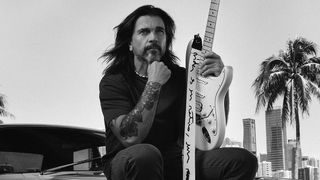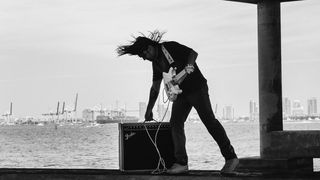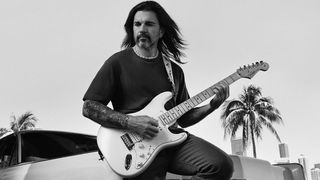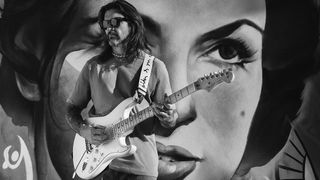You can tell a lot about a player by their choice of electric guitar. Take Juanes, and the new signature Stratocaster that the Colombian pop-rock superstar has spec’d up with Fender.
If this had arrived in an unmarked case, with factory issue neck plate as per its siblings in the American Professional II series, with which it shares the sculpted neck heel and pro-quality build, you might guess it was for a session player.
The Juanes Stratocaster is designed to cover all styles, with an Alnico II modern-voiced humbucker at the bridge, and two custom-voiced Ultra Noiseless Strat single-coils at middle and neck positions. It’s like a greatest hits of the Stratocaster.
It’s like a greatest hits of electric guitar. And then hiding under the master volume knob there’s an S-1 push switch that activates a mid-boost that has up to 12dB to play with – simply adjust the boost volume with the dedicated knob, with the third knob reserved for master tone.
All of this makes sense when you listen to Juanes’s back catalogue, and when you talk to him about music. Inevitably, the conversation will turn to Metallica.
Discovering the Bay Area’s very one Fab Four as a teenager transformed turned him into metalhead, a condition from which he is still recovering, and would inform how he would address his instrument, even if what he is playing is a pop arrangement adapted from a traditional Colombian vallenato or cumbia. But the latter styles, the South American folk music he was reared on is every bit as important, and so too textures gleaned from jazz, pop,
Listening to Juanes’s latest studio album, Vida Cotidiana (‘Everyday Life’), you can hear why he needs this Strat. It has to speak to all aspects of his personality – the dreamy, cinematic ‘60s vibe of opener Mayo, the 21st-century arena pop-rock ecstasies of Gris, the Caribbean soul of Cecilia that welcomes Juan Luis Guerra to the studio for a guest spot.
I went back to my essence and feel stronger now – even if on this album I am much more vulnerable, talking about very personal things
There’s a lot of sound to cover. And, of course, like any unreconstructed Metallica fan and proud of it, there’s also plenty of output on that bridge ‘bucker for metal, just in case. But then again, as he explains here, even if he is in Position 4 on his Strat, he is mostly likely deploying a downpicking technique that came from the king of downpicking, James Hetfield.
Let’s talk about this record first, because what you’ve said about it, it almost sounds like you approached this as though you were making your debut, as you though you were restored to factory settings?
“Yeah, I think so. Maybe because of my age. Maybe because of life in general. But somehow I feel I went back to my essence and feel stronger now – even if on this album I am much more vulnerable, talking about very personal things. But surrounded by the guitar, the drums, the bass, and the music itself, I feel stronger.
“Also, I feel honest. And that is something that I really, really like a lot when I am making music, so yes, this album means a lot for me because of all of these reasons.”
It takes strength and growth to be able to be honest and vulnerable, to talk about difficult personal things in song.
“There are two different ways to take this. You can be like that when you are young, when you are just being yourself, and then, through the years, maybe you have to change so much, but after time, for any reason, you go back to your essence and say, ‘This is who I am, and I just need to share it with the audience.’ And that’s the way I am now. That’s where I am now.
“It’s having a process, to be honest. Many, many different moments in my life, different things, brought me here. After success, after failure, after freedom, after fear! [Laughs] Many things! But definitely now, I feel honest and stronger speaking out and saying what I feel, and this is something that I want to keep on doing.”
You took some lessons from Tomo Fujita. What did he teach you? The track Veneno sounds like it might have been the sort of thing that he would coach you through, because that funk guitar sounds so… nice.
“Man! Actually, yesterday I had a lesson with him. He’s my favourite. I really love him. He’s such a nice person, the best guitar teacher ever. So I met him in Covid time. I was just at home trying to spend time learning different things, and I was on social media, and I started to see this guy everywhere. One day I just decided to send a direct message and he answered me, very nice, like, ‘Of course I can do lessons by Skype.’
Tomo Fujita such a nice person, the best guitar teacher ever... When I try to do things fast, he always says, ‘Don’t do it fast. Do it slowly first. Learn it step by step
“We became very good friends, and we started to work together, and actually we are writing a couple of things together, probably for one of my future albums. I don’t know if I am going to releases these songs but he sent me ideas and I worked them out.
“Yesterday we were learning a song from Tony Bennett, Because Of You, which is such a beautiful song that I wanted to learn and play on guitar, but I wanted to do it in the proper way.
“I was with him yesterday, learning, chatting. Yeah, man, he’s just an amazing person. And I think that is a very positive thing about all this social media. Sometimes I hate it. But sometimes you can find so many easy ways to connect with people and learn. Honestly, I study every day through YouTube, and websites, all the time.”
What’s the best piece of advice that Tomo gave you? What was his most important lesson?
“The most important thing for me is not to rush. Not to think that you are less or more than anybody. That kind of approach from the human side gives me comfort. When I try to do things fast, he always says, ‘Don’t do it fast. Do it slowly first. Learn it step by step. Then by the time you are going faster and faster, it’s like magic.’
“When you see a magician, everything is planning. And practice and practice and practice. They do it so fast and so well that you don’t even notice; you think it’s magic, but it’s not magic.
“The first time I spoke with Tomo, he said, ‘Okay, I am going to teach you something very, very boring, but it’s very important.’ [Laughs] Just do these exercises to clean up your playing.’ These chromatic exercises are really boring, but step by step, we are moving through different modes of learning. I find him a very, very incredible guitar player, songwriter, and a beautiful person to be honest.”
Music is funny, because it is like a battle with time and your own physiology. Your heart is going. You’re breathing. You don’t want to think about the tempo too much because then you start thinking it…
“Definitely, man. Yeah! The metronome. We all have one inside of us. Always. [Laughs] The heart.”
We must talk about this Strat, because it is a really interesting design. When did you have the idea for this midrange preamp? Because that’s like the magic frequency for the guitar. Did it the guitar make it onto the record?
“I am not a really bit technical guy. Like, I don’t have a lot of pedals, so for me the easiest way is just to have a guitar that can give me all the possibilities I need onstage. I mean, when I am in the studio – of course! I can work differently. But when I am onstage I want everything just here, inside my guitar, and easy for me.
I really like metal music. I really love metal. I have been into that since I was a teenager, so the noiseless pickups for me – and the humbucker – gives me that possibility too
“That midrange thing is something that I really love and it gives me the possibility to just go and play and have different sounds at the right moment when I need it. And I spent a lot of time working on the pickups. They sent me like this special pedal, so we were calibrating all the sounds on the guitar, the essence of my sound, but at the same time, as a Strat, it is very open.
“You can play all different types of music with this guitar. That is something I really like. Also, I really like metal music. I really love metal. I have been into that since I was a teenager, so the noiseless pickups for me – and the humbucker – gives me that possibility too if I want to play metal. I can just go there and have an incredible sound with the Stratocaster.”

This guitar is like a session player’s guitar. You’re a bit like a session player on your own album, because you cover so many different styles. There’s funk. There’s this weird guitar solo on Amores Prohibidos that comes out of nowhere and hits you, a rock ’n’ roll guitar solo on a dance song.
“Yeah! That’s like a perfect example more or less of why I am a musician, or how my world looks, because the origin of this song is really Colombian music. Then when I take this Colombian rhythm to the electric guitar, and I put on some distortion, then you start to dance to it. [Hums rhythm] But then the solo part is really rock ’n’ roll, like from the ‘50s, ‘60s. All of these elements together make something different.
“I remember the first time I was in LA, 1999, when I went to Guitar Center. I saw this wall full of guitars and I was like dreaming. When I was recording my first solo album, Fíjate Bien, I went to Gustavo Santaolalla’s studio, which was La Casa, I used a Telecaster, a Stratocaster, and a Fender amplifier throughout the album, and that gave me the sound, the sound of my music, and it is still my sound to this day. I use it a lot on this album, and I don’t know; there’s something about the sound that gives me something to connect with.”
Did you use the Acoustasonic on this record? You did a demo for Fender with the Jazzmaster. That is another guitar whose design fits in with your ethos?
“Yeah, I did a couple of things. I doubled a couple of things on one of the songs. It was probably Veneno or Ojalá. I didn’t use it so much on the album but I definitely use it to play live, and when we have acoustic sets.
“I really like this guitar. I saw Metallica and Kirk Hammett playing this acoustic guitar last year during a stream and it sounded great. It’s great, having these two elements together from the acoustic world and the electric world, working together. The neck is very gentle and nice. I really love this guitar, too.”

Metallica is such a rite of passage for guitar players. But it’s so regimented, it’s almost like you need deprogrammed when approaching other styles. How did you learn it, and then unlearn it, and what did you take from Metallica? What was the lesson you got from listening to them?
“Oh it is crazy, man. When I was 13 years old, I was living in Medellín. There was no internet, no YouTube, no nothing. Not even books with tablature. I was just by ear, with a cassette, just trying to learn Fade To Black or Seek And Destroy. I didn’t even know how to take the pick with my hands.
‘Okay, so I have to play all the time down so it sounds like Hetfield!?’ So I started to play like that all the time. I was in so much pain!
“I was just on an acoustic guitar, trying to learn this, and then, through my friends in Medellín, we started listening to metal music, to listen to all different types of music, but then I started to understand that [Metallica] were playing this downpicking style. ‘Okay, so I have to play all the time down so it sounds like Hetfield!? Okay, I’m going to do it.’ So I started to play like that all the time. I was in so much pain! So much pain – because it was hard for me.
“I said, ‘Okay, I need to relax. I need to breathe.’ I learned by practising all day, and then when I started making my own music, okay, I realised that I was not going to be him – I was not going to be Hetfield. Never, ever! [Laughs] I was just going to be Juanes, myself. So I started to bring those elements from the downpicking style to my music.

“I started to play vallenatos and cumbia but always using downpicking. ‘Okay, this is good. This is different, sounds cool!’ That was the way Metallica has had so much influence in my playing even if my music doesn’t have any distortion. It is just how I hit the string, the angle, many different things. Probably, inside, I’m playing Battery or Seek And Destroy but I’m not doing that. I’m playing La Camisa Negra, and it gives me something different.
“And I love those guys. When I was 15, I was in my room in Medellín, and used to have posters of Metallica. And I was dreaming. I wanted to be like them. I wanted to be like them and travel the world. They inspire me so much. It’s just crazy.”
That’s music. It shortens the distances between cultures. You can go from Ride The Lightning to vallenato in one arrangement. You didn’t speak English in those days. Did that help you go deeper into the music? There’s a freedom in hearing a song in a different language. We can interpret how we like.
The sound of the guitar with distortion, the drums, everything about it just gave me so much happiness
“Yeah, probably. Forty years ago, in Medellín, not too many people spoke English. In my case, I did not speak a word! So for me it was more about interpretation, and I would ask my friends, ‘Do you know what this lyric means?’
“But I was always into the music. For me, the sound of the guitar with distortion, the drums, everything about it just gave me so much happiness.
“And Medellín was a very difficult city, so I think, in that moment, just to find rock music, metal music, was like an escape. It gave me so much power. I never, never got any of the lyrics until recent years when I started to realise what they were talking about – and now I like it even more.”
You have acquired so many layers to your sound. Going back to Veneno, with the funk guitar, the guitars are so light, they’re like a soufflé. The notes are almost in the air. If you grew up on Metallica, who brought that to your playing?
“I am the youngest of six brothers and sisters. When I was a kid, all of my brothers and my father used to sing folk music at home, so I was always surrounded by my parents singing and playing guitar, or my brothers playing guitar.
“Ever since I was conscious, I saw them singing and performing, so my first approach to music was really through that kind of music, vallenato, cumbia, tango, bolero. Then, when I turn 13, 14, when I’m at school, I then learned about rock. Before that, nothing. For me it was just acoustic guitar and old folk music from South America. That was very important for me, because my first approach was that and then I became a metalhead, and then I went back to my roots.

“Now I love to listen to all types of guitarists, from Stevie Ray Vaughan to Wayne Krantz, Tomo Fujita, Joe Pass, anybody… David Gilmore, Hetfield, I really appreciate music in all different languages and all different genres and it always gave me something new.
“I am definitely not like a very, very good player, like a very fast guy. I’m not like that. But I use the guitar everyday to live. I live through the guitar. For me, this is like a projection of my soul. I write my music and it helps me to just get calm, to dream in the future, to connect with my family – to connect with anything around me. I mean, the guitar for me is something more important than just a guitar. It means a lot.”
I write my music and it helps me to just get calm, to dream in the future, to connect with my family – to connect with anything around me
That brings us back to the start, with the honesty and vulnerability we spoke about. The guitar is a good way to access that. It makes you feel better when you hold it, and as a songwriter, that lets you project your vulnerability elsewhere, into the song.
“Yeah, man. I paint feelings with the guitar. Sometimes I just sit here by myself, sometimes happy, sometimes sad, whatever, and I start to play, and I don’t even realise what I am doing from one moment to another, then I’ll say, ‘Oh, I like this. This is something that has to do with the feeling I’m having.’ And I’ll start to work with that.
“It helps me so much. It’s like therapy for me to play. On other days, if I have nothing to write I’ll just practise and that gives me this kind of mood, like a meditation type of thing.”
- Vida Cotidiana is out now via UMG. The Fender Juanes Stratocaster is out now. See Fender for more details.


